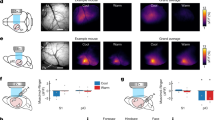Abstract
Information provided by the analysis of peripheral cold and warm receptors may be considered a useful guide for assessing the specificity of thermal information originating in deep-body tissues. A wealth of data concerning the location of deep-body thermosensors and their neuronal correlates and modes of transduction permits the following theses to be proposed.
1. Unlike the peripheral warm and cold receptors, deep-body thermosensors are only in part represented by afferent fibers, mostly warm sensitive ones that are not character- ized in detail, as the source of thermal information outside the central nervous system (CNS). The more important thermal information generated in the CNS originates mainly from warm-sensitive neurons but contributions of cold-sensitive neurons are not definitely excluded.
2. Unlike the peripheral thermoreceptors, monomodality with respect to natural physical stimuli does not seem to be an essential property of deep-body thermosensors. By contrast, multimodality may underlie at least some of the multitude of interactions between thermoregulatory and other homeostatic control systems.
3. Temperature transduction seems to utilize molecular mechanisms that are also found in neurons that lack any thermosensory functions, and so the transduction mechanisms identified in warm-sensitive CNS neurons do not seem to be specific per se.
4. The observation of a multitude of temperature/response characteristics for thermosensitive CNS neurons has been helpful for categorizing these neurons, but there is no clear information that any one might be particularly relevant.
5. Originating from the peripheral cold and warm receptors two separate but interacting cold- and warm-signal pathways ascend multisynaptically to the hypothalamus as the highest level of thermoregulatory control, and to some extent go further to the sensory cortex. The signal contributed by a deep-body thermosensitive neuron, irrespective of its location, attains specificity by being fed properly into one of the two ascending thermosensory pathways.
Similar content being viewed by others
Author information
Authors and Affiliations
Additional information
Received: 25 January 2000 / Accepted: 10 April 2000
Rights and permissions
About this article
Cite this article
Simon, E. The enigma of deep-body thermosensory specificity. Int J Biometeorol 44, 105–120 (2000). https://doi.org/10.1007/s004840000060
Issue Date:
DOI: https://doi.org/10.1007/s004840000060




